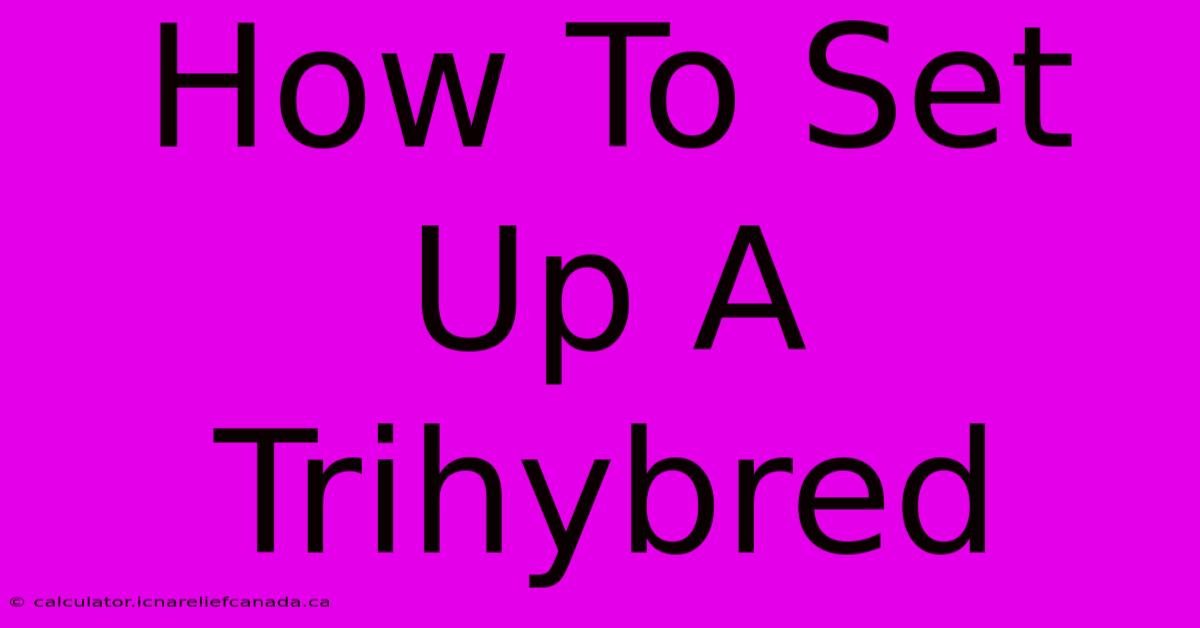How To Set Up A Trihybred

Table of Contents
How To Set Up A Trihybrid Cross: A Comprehensive Guide
Understanding trihybrid crosses is crucial for grasping Mendelian genetics. A trihybrid cross involves tracking the inheritance of three different traits simultaneously, making it more complex than monohybrid (one trait) or dihybrid (two traits) crosses. This guide will walk you through setting up and solving a trihybrid cross, step-by-step.
Understanding the Basics: Genes, Alleles, and Traits
Before diving into the mechanics of a trihybrid cross, let's review some fundamental genetic concepts:
- Genes: Units of heredity that determine traits.
- Alleles: Different versions of a gene. For example, a gene for flower color might have alleles for red (R) and white (r).
- Traits: Observable characteristics determined by genes (e.g., flower color, plant height, seed shape).
- Homozygous: Having two identical alleles for a gene (e.g., RR or rr).
- Heterozygous: Having two different alleles for a gene (e.g., Rr).
- Genotype: The genetic makeup of an organism (e.g., RrYy).
- Phenotype: The observable characteristics of an organism (e.g., red flowers, tall plant).
Setting Up the Trihybrid Cross: An Example
Let's consider a plant with three traits:
- Flower color: Red (R) is dominant to white (r).
- Plant height: Tall (T) is dominant to short (t).
- Seed shape: Round (S) is dominant to wrinkled (s).
We'll cross two heterozygous plants: RrTtSs x RrTtSs.
Step 1: Determine the Gametes
The first crucial step is to determine all possible gametes (sex cells) each parent can produce. Because of independent assortment, each allele pair segregates independently. To find the gametes, consider all possible combinations of alleles:
For RrTtSs, the possible gametes are: RTS, RtS, rTS, rtS, RTs, Rts, rTs, rts.
Step 2: Create the Punnett Square (Optional but Recommended)
While a 64-square Punnett square is possible (and incredibly large!), it's often more manageable to use probability instead. However, constructing a partial Punnett square can help illustrate the principles. A full Punnett square would be visually overwhelming and not necessarily the most efficient method.
Step 3: Using Probability for Efficiency
Instead of a large Punnett square, let's use the probability method. This is significantly more efficient for trihybrid crosses. For each trait, we'll calculate the probability of each genotype and phenotype:
- Flower Color: The probability of RR is 1/4, Rr is 1/2, and rr is 1/4.
- Plant Height: The probability of TT is 1/4, Tt is 1/2, and tt is 1/4.
- Seed Shape: The probability of SS is 1/4, Ss is 1/2, and ss is 1/4.
To find the probability of a specific genotype (e.g., RRTTSs), we multiply the individual probabilities: (1/4) * (1/4) * (1/2) = 1/32.
Step 4: Calculating Phenotype Probabilities
To find the probability of a specific phenotype, consider all possible genotypes that produce that phenotype. For example, the probability of a red-flowered, tall, round-seeded plant (R_T_S_) involves multiple genotypes. You would sum the probabilities of all genotypes producing that phenotype. This requires considering all combinations that result in the dominant phenotype for each trait.
Advanced Considerations: Linkage and Epistasis
The example above assumes independent assortment. However, in reality, genes located close together on the same chromosome may exhibit linkage, meaning they don't assort independently. Furthermore, epistasis, where one gene influences the expression of another, can also complicate trihybrid crosses.
Conclusion: Mastering Trihybrid Crosses
Trihybrid crosses represent a challenging but rewarding aspect of genetics. While a full Punnett square is impractical, using probability provides a more efficient and accurate approach. Mastering this technique strengthens your understanding of inheritance patterns and prepares you for more complex genetic problems. Remember to break down the problem into individual traits and utilize the power of probability to solve for genotypes and phenotypes.

Thank you for visiting our website wich cover about How To Set Up A Trihybred. We hope the information provided has been useful to you. Feel free to contact us if you have any questions or need further assistance. See you next time and dont miss to bookmark.
Featured Posts
-
How Toxic Is A Porcupine Tomato Video For Kids
Feb 08, 2025
-
How To Open Warzone In The New Update
Feb 08, 2025
-
How To Allow Interactive Animals In Planet Zoo
Feb 08, 2025
-
How To Draw The Twin Towers Plane Hit
Feb 08, 2025
-
How To Make A Title Page In Google Slides
Feb 08, 2025
